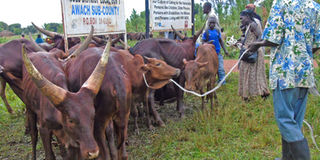Locals reap from cattle restocking programme

Herding. Some of the beneficiaries of cattle restocking programme in Acholi Sub-region. PHOTO BY JAMES OWICH
What you need to know:
- Supplies. District officials say more than 1,000 animals have been given out to beneficiaries since 2015.
- Although the programme has registered success, Dr Okwir says they have been let down by some beneficiaries who relocate from places where they were meant to keep the animals.
Nwoya. More than 1,000 beneficiaries of cattle restocking in Nwoya District have a reason to smile after their animals started multiplying.
In 2014, government earmarked Shs20b for cattle restocking in northern region under the Peace Recovery and Development Plan (PRDP) programme. This follows the two-decade rebel insurgency that ravaged the region since1986.
Out of the Shs20b, Shs5b was committed to expanding the livestock restocking programme in Acholi, targeting mainly former rebel combatants, orphans, former abductees, child-headed families, child mothers, widows and elderly persons.
Each district in Acholi Sub-region was allocated Shs500m and procurement process was conducted by the Office of the Prime Minister (OPM).
Some of the animal breeds Nwoya District received included; Boran, Zebu and Long-horned Ankole cattle.
Ms Anna Awekonimungu, who received a cow in 2015, says the cow remained her only source of livelihood.
“As I talk now I have three animals. I am able to get milk for my family and sell the surplus,” she boasts.
Positive change
Besides sustaining her family with basic needs, Ms Awekonimungu says she is able to cater for her children’s educational needs.
Mr Joseph Kakama Okello, a former Lord Resistance Army (LRA) abductee, says the animals have been a turning point in his life.
“I am no longer a beggar since I was given a net to fish. I make a living through selling milk. I use the animal waste to improve yields in my garden,” he says.
The Nwoya District LC5 chairperson, Mr Patrick Okello Oryem, told Daily Monitor in an interview: “The animals are doing well and I am happy that in some homes there is already positive change in the lives of the beneficiaries.”
He said some beneficiaries in Purongo, Kochgoma and Alero Sub-counties have three to four animals.
According to the Nwoya District veterinary officer, Dr James OKwir, since the progrmme was introduced in the district, they have received animals in three consecutive financial years.
“More than 1,000 animals have reached the beneficiaries and we have recorded success stories in some areas where the animals have been kept well,” he said.
Challenges
Although the programme has registered success, Dr Okwir says they have been let down by some beneficiaries who relocate from places where they were meant to keep the animals.
“Monitoring some animals in some areas has not been easy since some beneficiaries relocated, while others sold them off,” he said.
Background. Government in May 2015 under the Office of the Prime Minister carried out a restocking programme for cattle in eastern and northern Uganda. The programmed mainly targeted persons with disabilities, orphans, and widows who were urged to follow the restocking guidelines and keep the animals for at least four years.



